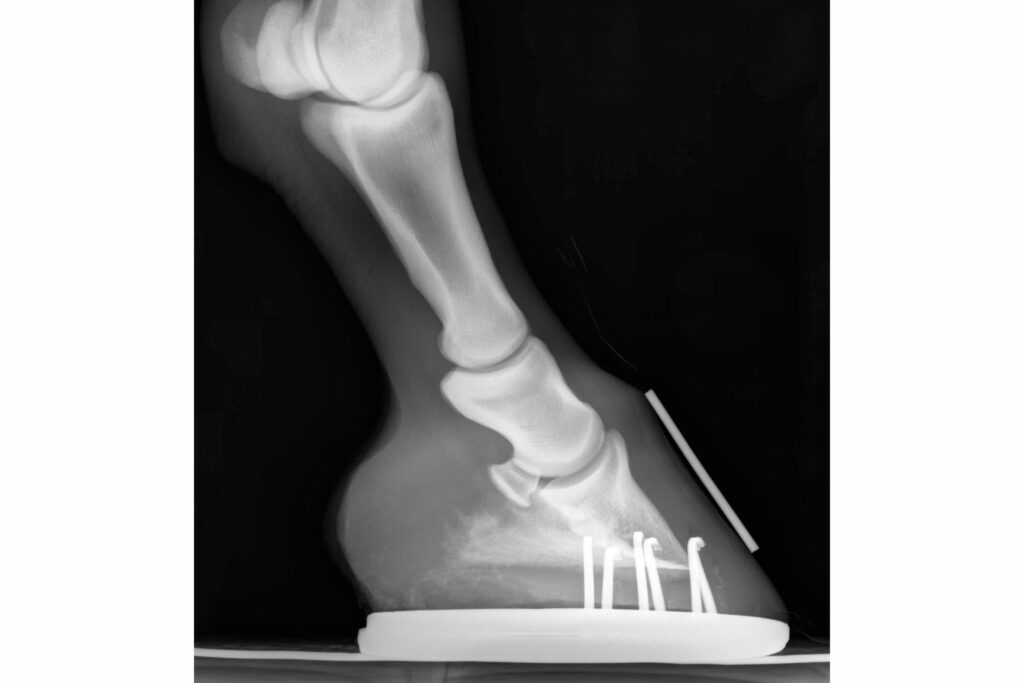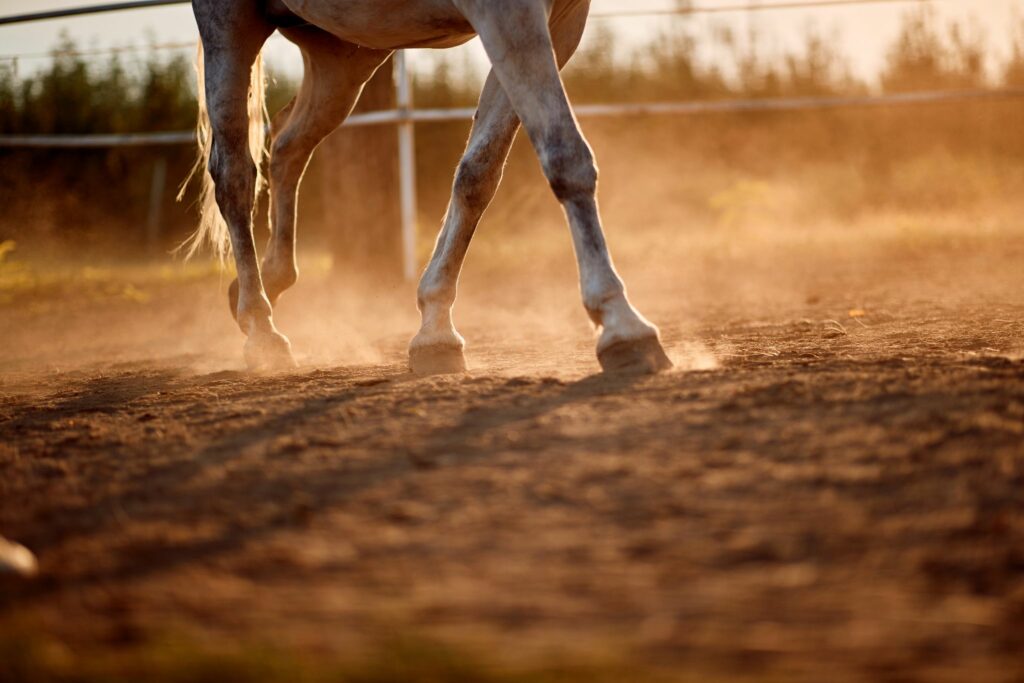Horse News
Member
Laminitis for the Horse Rookie
Founder, also known as laminitis, is a unique and challenging disease in the horse world. With a complex range of causes, it can be difficult to spot until the damage has already been done. In less severe cases, the right combination of veterinary care and farrier work can help make cases manageable.
Founder, or laminitis, is a complicated disease that can be difficult to spot. Preventative measures can be taken, like limiting grazing time in the spring when sugars in grass are high. The signs of laminitis include heat in the hooves, resistance to moving, putting more weight on the hind legs, or laying down more frequently. In mild or moderate cases, corrective shoeing and dietary adjustments can help horses live comfortably, with some able to return to light riding.
Founder Defined
Founder and laminitis are different names for the same condition. Laminitis, which is called founder in the more advanced/severe cases, happens when the laminae of the foot become inflamed.
The laminae is the soft tissue that connects the coffin bone to the hoof wall.
This inflammation is painful and causes the coffin bone to become unstable, leaving the hooves deformed or weakened. Once a horse has an episode of laminitis, they are much more likely to experience it again.
Causes of Founder (Laminitis)
- Overfeeding
- Excessive grain consumption
- Obesity (particularly in ponies)
- Prolonged lameness (the horse consistently puts more weight on one leg)
- Endocrine diseases (like PPID, aka Cushing’s)
- Repeated strikes on hard ground (walking barefoot on hard surfaces like roads)
- Lush grass (most commonly spring grass)
- Equine Metabolic disease
- Insulin resistance

Photo Cred: Canva
Is founder the same thing as laminitis?
Yes! Founder is considered a more severe version of laminitis, usually with more advanced damage and inflammation.
What causes a horse to founder?
There are several causes of Founder, most of which relate to sugar intake and how a horse’s body breaks down said sugar.
Horses with insulin resistance, equine metabolic disease, those on a high-grain diet, or horses exposed to spring pasture are the most prone.
What is the worst time of year for founder (laminitis)?
Spring was long considered the worst time of year for laminitis, but it can happen at any time. There are near-constant fluctuations in sugar levels in grass that can affect or cause laminitis.
The more NSCs, or non-structural carbohydrates, a horse eats, the higher the risk of decreased blood flow to the hooves, which causes laminitis.
Grass in direct sunlight, grass that is growing quickly, pastures in late afternoon/early evening, or when the days are hot but the nights are cool (the grass doesn’t need to use its stored sugar at night, so the levels tend to stay high) are all conditions in which laminitis is more likely to occur.
Diagnosing Founder (Laminitis)
Most vets will x-ray the hoof to check the degree of damage and to see if any rotation of the pedal bone has occurred.
Your vet may also do bloodwork to check for any underlying causes like an endocrine disease. These results can help you manage the condition in the future.
Phases of Founder (Laminitis)
Developmental – the early stages of laminitis. The laminae are starting to show signs of damage; however, the horse is unlikely to show outward signs of the disease.
Acute – the stage during which laminitis becomes outwardly visible. Coffin bone rotation may occur, but not always. Horses will likely show hoof heat, sudden lameness, frequent weight shifting, or the classic “founder” stance (leaning heavily on the back legs).
Chronic – the stage at which laminitis may be called founder. Pain and lameness occur for prolonged periods due to the rotation of the coffin bone. Special farrier care will be needed.
Grass Founder in Horses
Grass founder is the same as any other type of founder, but is mainly caused due to prolonged exposure to and consumption of grass high in sugars.
How quickly can a horse founder on grass?
A horse can founder on grass in as little as a few hours!

Photo Cred: Canva
Founder (Laminitis) Symptoms
The symptoms of founder/laminitis can vary depending on how severe the case is. Typically, the more damage the laminae have sustained, the more severe the outward symptoms will be.
Some common symptoms include:
- Increased pulse in the hoof
- Heat in the hoof
- Sudden onset of lameness (can be minor or more severe)
- Resistance to movement (especially walking)
- Laying down more often than is normal
- Unwilling to bend their legs
- Frequent shifting of weight between legs
- Placing significantly more weight on the hind legs
Feeding the Foundered Horse
While diet is always important, it’s especially significant after a horse has a bout of laminitis or founder. The main goal is to minimize the intake of NSCs, or non-structural carbohydrates, by feeding a low-starch diet.
Feeds that are high in magnesium and amino acids are thought to enhance circulation.
Avoid feeds that have corn, barley, oats, and sugars (like molasses). If your horse struggles to maintain its weight (skinny horses can suffer from laminitis, too), opt for adding rice bran or oils.
Molasses-free beet pulp can be a great option for additional forage.
Most laminitic horses can safely eat hay, provided the NSCs are below 10% (you can find this out through testing). Typically, Rhodes, Timothy, and Teff grass hays are safe.

Photo Cred: Canva
Recovery Time After Foundering
Recovery time varies widely and depends on how much damage occurred. If there is no rotation of or damage to the coffin bone, recovery time could be as little as six to eight weeks.
Before restarting a horse under saddle, make sure they are off any anti-inflammatories (like Bute) and have been seen by a farrier.
A good farrier can do a hoof test (to check for any sensitive areas) and can make sure there are no hoof imbalances. Make sure to bring your horse back slowly and on soft footing.
For most horses, recovery can take anywhere from two to three months. It’s best to start with hand-walking before moving on to light riding.
More severe cases can have recovery times of six months to a year. In some extreme cases, euthanasia is the most humane option.
When Laminitis Becomes Fatal
Some horses may need to be put down after a severe case of founder. This will vary case by case, but most vets will recommend euthanasia if the pedal bone completely detaches from the hoof wall.
Horses with a high degree of bone rotation, typically 15 degrees or higher, may be permanently lame (and in pain).
Choosing to euthanize a horse is a difficult decision. If your horse has reached the point where your vet has advised euthanasia or if your horse is in constant pain, this article can help you plan for the hard goodbye.
Long-Term Prognosis of Laminitis
Despite the severity of this disease, when caught early, laminitis can have a high recovery rate.
According to one survey, 74% of horses recovered and were able to return to full work.
Can horses recover from founder?
While most horses can recover from founder, some may experience issues with ongoing pain or life-long lameness.
Remember, there is no cure: only recovery and preventing further damage.
Most horses will require strict diets and special farrier care after foundering. Horses with laminitis may be able to return to full work but will have to be carefully supervised to prevent a recurrence.

Photo Cred: Canva
Are there any home remedies for founder in horses?
While founder can be treated at home, all treatments should be supervised by a vet and include help from a qualified farrier.
Restrict grain intake and feed only low NSC options. In more severe cases, limit turnout to dry lots only (no pasture). You can also add extra cushioning to your horse’s stall to maximize comfort, whether that be adding thicker rubber floor mats, or extra bedding.
Once your horse has recovered, keep a close eye on his weight to prevent obesity and slowly return him to work, making sure to ride only on soft surfaces.
Many owners choose to supplement with magnesium, which can increase blood flow.
Can a foundered horse be ridden again?
In some cases, yes. Minor cases, or the first onset of laminitis, typically see quick recovery times (six to eight weeks) and a full return to work (though this does take time).
Start with hand-walking and work up to forty-five minutes, two to three times a day before reintroducing riding. Once under saddle, ride only on soft surfaces, and start with walking. Build up slowly over several months.
Most horses who have recovered from laminitis may need shoes for a time, but getting them barefoot is ideal to help maintain optimal hoof health. The need for shoes to maintain soundness, however, can vary from case to case, so work with your vet and farrier to determine what will make your horse the most comfortable.
Preventing Laminitis
Fortunately, there are several steps you can take to help prevent laminitis:
- Maintain a regular farrier schedule
- Annual veterinary wellness checks (look for conditions like EMS, PPID, and more)
- Monitor diet (introduce pasture slowly, feed minimal grain, feed grains low in NSCs, etc.)
- Avoid long rides in barefoot horses on hard surfaces

Source: Canva
How do you prevent a horse from foundering?
There are several steps you can take to help prevent founder. Limit turnout on grass pastures and slowly increase grazing time. Use grazing muzzles to limit grass intake and avoid turning out in the early mornings or late afternoon/early evening.
Ask your vet to do bloodwork to check for conditions that put your horse at risk, like EMS, insulin resistance, or PPID (Cushing’s).
If your horse has elevated risk factors, consider switching to a low-sugar, low-starch (low NSC) grain. If your horse is a hard keeper, use oil or rice bran instead of feeding larger rations of grain to add or maintain weight.
Frequently Asked Questions
Q: How can you tell if a horse is foundering?
There are several signs of founder, including a sudden onset of lameness, heat in the hoof, and resistance to moving. Most horses won’t show outward signs of this disease for a while. By the time clinical signs, like lameness, are present, damage is already well underway.
Q: How do you cure founder in horses?
Unfortunately, founder can’t be cured, but it can be managed. Many vets will recommend a period of strict stall rest (to minimize rotation) along with a round of anti-inflammatories (like bute) and cold hosing to help decrease inflammation.
Once a horse has experienced founder (or laminitis), they are more likely to experience it again. Taking preventive measures, like switching to a low-NSC grain and reducing grazing time can help prevent a recurrence.
Q: What are signs of grass founder in horses?
The signs of grass founder are typically the same as with ‘regular’ founder. Your horse may suddenly appear lame, may resist putting weight on their front legs, or may lay down more frequently than usual.
Q: What is the mortality rate of laminitis/founder?
According to the Royal Veterinary College, over 7% of equine deaths have a link to laminitis. Most cases aren’t fatal, especially if they are caught early and steps are taken to manage the condition. After recovery, many horses can even return to full work.
Q: Can a laminitic horse live out its days comfortably?
It depends on how severe the laminitis is. In minor cases, proper hoof care and managing sugar intake can help a horse live comfortably for many years. Others will need special shoes and regular farrier visits to minimize pain. In the worst cases, where a horse is habitually lame and unable to comfortably stand even with regular treatment, it may be time to consider euthanasia
Parting Thoughts
Laminitis can be a devastating diagnosis, but it’s a very treatable disease. While the damage caused by inflammation can’t be reversed, it’s possible to take steps (through vet care, good farrier work, and diet) to prevent further damage.
For most horses, laminitis is a temporary setback, and they can continue to lead long and healthy lives!
P.S. Enjoy this article? Trot on over to:
- Gimmick or Guarantee? Low Starch Horse Feed
- Three Types of Horse Feed Every Owner Should Understand
- How to Soak Hay for Horses (And Why Bother)
- Alfalfa Cubes vs. Pellets: What’s Best for Your Horse?
- Stall Flooring for Homebody Horses
- Horse Hoof Terminology Every Equestrian Should Know
- Get a Leg Up on Equine Leg Terminology
- 20+ Horse Technology Essentials That Make Life Easier
Sources
https://ceh.vetmed.ucdavis.edu/health-topics/laminitis
RVC Equine Laminitis Facts and Research
Grass Founder | AAEP
Founder in Horses: Causes, Symptoms, Treatment and Prevention | Mad Barn
What is laminitis, and how can it be prevented or treated? – RSPCA Knowledgebase
The post Foundering in Horses: Figure Out Your Fix appeared first on Horse Rookie.
Continue reading...
